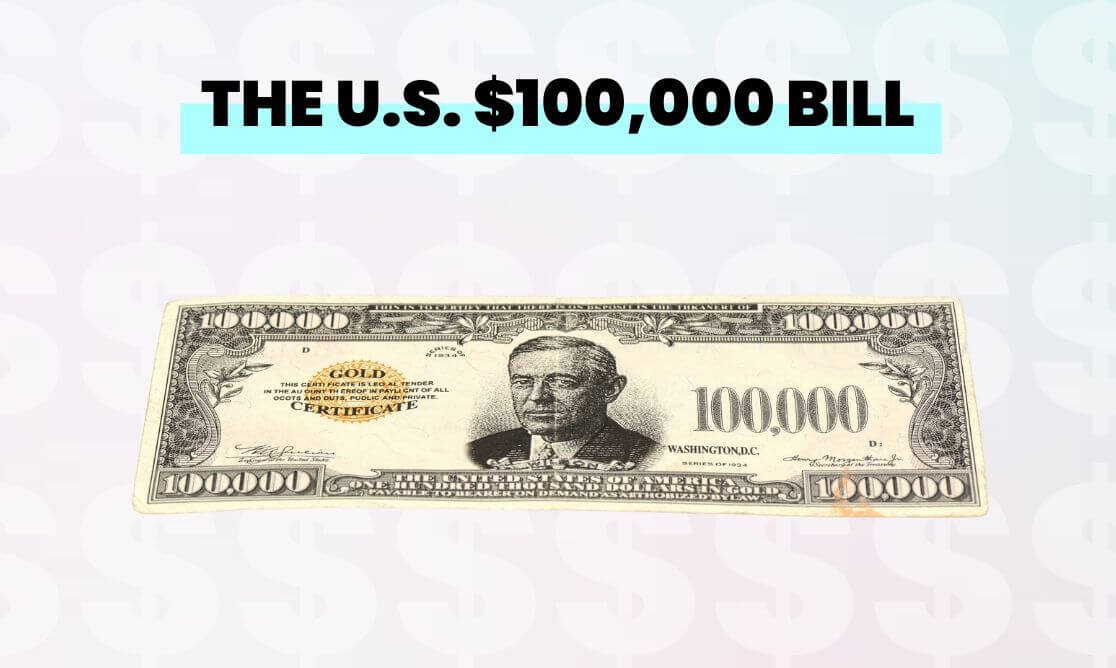The $100,000 bill, known as the "Gold Certificate," is a remarkable and rare piece of American currency. Although unfamiliar to many, this note carries significant historical and monetary value.
Read on to learn about the intriguing history behind the $100,000 bill, shedding light on its distinct design and notable characteristics. And if you're in the fortunate position to have one in your possession, find out how what security features to check when authenticating a $100,000 bill.

Coming up next
Key takeaways
- The $100,000 bill was the highest denomination of US currency ever printed. However, it was not intended for public circulation and instead served as a means for facilitating large-scale transactions between Federal Reserve Banks.
- Featuring a portrait of President Woodrow Wilson, the $100,000 bill symbolizes a significant era in American history.
- The bill was officially discontinued in 1969 by the Federal Reserve to combat illicit activities such as money laundering.
- The $100,000 bill is not considered legal tender and has no face value. It also cannot be legally held by currency note collectors.
History
The history of the $100,000 bill dates back to its initial issuance in 1918 as part of the Federal Reserve Bank Note series. Unlike other banknotes available in various denominations, the $100,000 bill was distinctively printed in a single denomination, making it an exceptional and exclusive piece of American currency.
From 1918 to 1945, the $100,000 bill played a special role in facilitating transactions between different banks. It wasn't meant for regular use by the public but was used by banks to transfer large sums of money between themselves during the early 20th century.
Why was there a $100,000 bill?
The creation of the $100,000 bill served a specific purpose in facilitating large-scale transactions between banks. The primary users of the bill were the Federal Reserve Banks and the Treasury Department. They relied on this high-denomination note to move substantial sums of money between different banks. It played a crucial role in streamlining interbank transactions, allowing for efficient funds transfer. It has been replaced by electronic means of transfer, such as CHIPS, SWIFT, and Fedwire.
Given its limited circulation and exclusive usage, the $100,000 bill remained largely unfamiliar to the average person.
How to identify a genuine $100,000 bill
It is important to note that identifying a genuine $100,000 bill can be challenging, primarily because these bills are incredibly rare and not readily available for public circulation. Nonetheless, here are key elements to look for:
- Design. The $100,000 bill showcases a portrait of President Woodrow Wilson on the front side. And on the back of the bill, there is an image of the United States Capitol, a prominent symbol of American democracy.
- Paper and texture. The bill is printed on high-quality paper, which gives it a distinct texture. The use of premium paper was a deliberate choice to ensure the bill's durability and prevent counterfeiting.
- Serial number. Each $100,000 bill has a specific serial number assigned to it. These serial numbers serve as unique identifiers for each individual bill. Checking the serial number can help determine the authenticity of the bill, as counterfeiters often struggle to replicate genuine serial numbers accurately.
- Signatures. The signatures of key officials on the $100,000 bill are also unique to each bill. These signatures represent the individuals in authoritative positions during the time of issuance. Comparing the signatures on the bill in question to known examples can help validate its authenticity.
Who is the president on the $100,000 bill?
The $100,000 bill prominently displays a portrait of President Woodrow Wilson, who served as the 28th president of the United States.
Wilson's presidency spanned from 1913 to 1921, a crucial period in American history. He is widely recognized for his leadership during World War I and his influential role in shaping international diplomacy through his advocacy for the establishment of the League of Nations.
Why was the $100,000 bill discontinued?
The $100,000 bill was officially discontinued by the Federal Reserve in 1969 as part of a broader effort to combat illegal activities, particularly money laundering. The decision to discontinue the bill was driven by concerns regarding its potential misuse for illicit purposes.
At the time, authorities recognized that high-denomination bills like the $100,000 bill could facilitate hidden or anonymous transactions, making them attractive to individuals involved in illegal activities such as money laundering, tax evasion, and organized crime. By discontinuing the bill, the Federal Reserve aimed to enhance transparency, accountability, and the ability to track financial transactions.
How much is a $100,000 bill worth now?
The $100,000 bill, while fascinating and historically significant, does not possess a current monetary value in terms of face value or legal tender. Since the bill is no longer in circulation and was never intended for general use by the public, it holds no practical worth in everyday transactions.
Moreover, it is important to note that owning a $100,000 bill as a private individual is not permissible under current regulations. The bill was primarily used for interbank transactions between Federal Reserve Banks and was not meant to be held by currency note collectors or individuals.
In conclusion
The $100,000 bill holds a unique place in American history as one of the most intriguing and lesser-known banknotes. It was primarily used for large bank transactions, but its usage became unnecessary over time. Eventually, it was discontinued due to concerns that its high denomination made it an attractive target for criminals.
Like smaller bills such as the $1,000 bill, the $100,000 bill is not legal tender, meaning it cannot be used for everyday transactions. Also, it cannot be legally held by currency note collectors.

